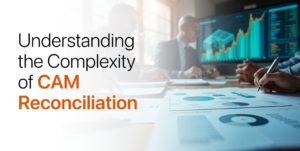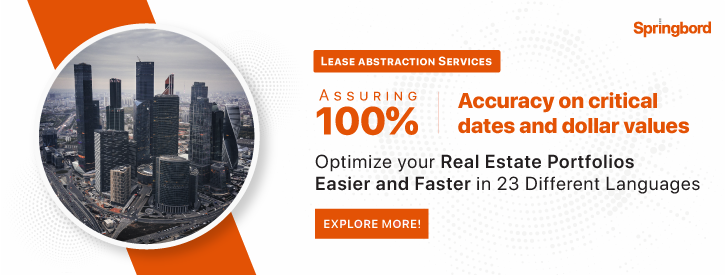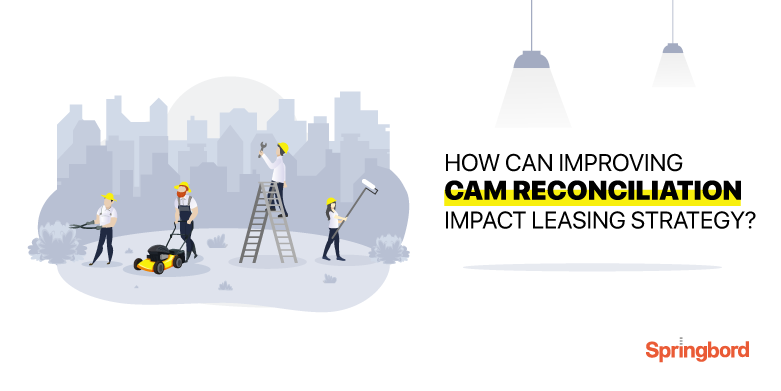 Read time 6 min
Read time 6 minIn real estate management, Commercial Common Area Maintenance (CAM) reconciliation stands as a pivotal process. It’s the mechanism through which landlords recover expenses incurred in maintaining shared spaces within commercial properties. While seemingly straightforward, CAM reconciliation poses significant challenges for real estate business owners, necessitating a closer look at its complexities and implications.
At Springbord, we recognize the critical role CAM reconciliation plays in optimizing the financial performance of commercial properties. Our expertise in lease management software and data analytics empowers real estate business owners to navigate the complexities of CAM reconciliation with confidence.
CAM Reconciliation
CAM reconciliation involves the meticulous assessment and allocation of expenses associated with the upkeep of common areas shared by tenants within commercial properties. These expenses encompass a wide array of operational costs, including utilities, maintenance, repairs, and insurance.
The reconciliation process ensures that these expenses are accurately apportioned among tenants based on their respective lease agreements.
Significance in Real Estate Operations
Commercial Common Area Maintenance (CAM) reconciliation holds a profound significance. It serves as a crucial process in ensuring the financial stability and operational efficiency of commercial properties. Understanding the pivotal role CAM reconciliation plays is imperative for real estate business owners to navigate the complexities of this aspect effectively.
Furthermore, CAM reconciliation plays a vital role in fostering positive landlord-tenant relationships. A survey conducted by BOMA International revealed that 84% of tenants consider transparency in operating expense calculations as important or very important. Transparent CAM reconciliation processes not only instil trust but also contribute to tenant satisfaction and retention, ultimately reducing vacancy rates and maximizing rental income for property owners.
Challenges Faced by Real Estate Business Owners
Real estate business owners confront a myriad of obstacles when it comes to executing Commercial Common Area Maintenance (CAM) reconciliation effectively. Let’s delve into these challenges:
Complex Lease Agreements: Real estate professionals often grapple with the intricacies of lease agreements and CAM expense clauses. This complexity demands meticulous attention to detail and specialized expertise to interpret and implement CAM provisions accurately amidst varying lease terms.
Labour-Intensive Processes: CAM reconciliation is inherently labour-intensive, posing significant resource constraints for real estate business owners. Manual processes not only increase the likelihood of errors but also consume valuable time and manpower, hindering operational efficiency and scalability.
At Springbord, we recognize the multifaceted challenges faced by real estate business owners in CAM reconciliation. Leveraging our expertise in lease management software and data analytics, we empower our clients to overcome these obstacles with confidence.

Understanding the Complexity of CAM Reconciliation
Commercial CAM reconciliation stands as a critical process that demands meticulous attention and understanding. Despite its apparent simplicity, CAM reconciliation is a multifaceted endeavour, encompassing various components, regulations, and resource-intensive procedures.
Components of CAM Charges
CAM charges comprise a multitude of expenses essential for maintaining shared spaces within commercial properties. These expenses encompass utilities, janitorial services, landscaping, repairs, insurance, and property management fees, among others. Understanding the diverse components of CAM charges is important for accurate allocation and equitable distribution among tenants.
Regulations and Compliance Issues
Regulations governing CAM charges vary by jurisdiction and are subject to interpretation, often leading to disputes between landlords and tenants. Compliance with lease agreements and regulatory requirements is crucial to avoid legal liabilities and maintain transparency.
Staying abreast of regulatory updates and ensuring adherence to compliance standards are imperative in CAM reconciliation processes.
Time and Resource Intensive Process
CAM reconciliation is undeniably a time and resource-intensive process, requiring substantial manpower and technological infrastructure. Manual data entry, disparate systems, and complex calculations contribute to inefficiencies and errors in the reconciliation process. According to a survey by MRI Software, 54% of property managers struggle with the time-consuming nature of CAM reconciliation. Implementing automated solutions and leveraging advanced analytics can streamline CAM reconciliation, optimize resource allocation, and enhance operational efficiency.
At Springbord, we recognize the intricate nature of CAM reconciliation and offer tailored solutions to address these challenges. Through our innovative approach, we ensure accurate, compliant, and efficient CAM reconciliation processes, enabling real estate businesses to maximize profitability and operational efficiency.

The Case for Outsourcing CAM Reconciliation
The outsourcing of Commercial CAM reconciliation has emerged as a strategic imperative for businesses seeking to optimize operational efficiency and financial performance. Let’s look at compelling reasons why real estate enterprises should consider outsourcing CAM reconciliation, emphasizing the tangible benefits it offers.
Cost Savings and Resource Allocation
By outsourcing CAM reconciliation to specialized service providers, businesses can minimize overhead costs associated with in-house staffing, infrastructure, and technology investments. Moreover, outsourcing allows for flexible resource allocation, enabling businesses to redirect human and financial resources towards core revenue-generating activities.
Access to Specialized Expertise
CAM reconciliation requires a good understanding of lease agreements, regulatory compliance, and accounting principles. Outsourcing firms employ skilled professionals with domain-specific knowledge and experience, ensuring accurate interpretation and implementation of CAM provisions.
Additionally, outsourcing partners leverage advanced technologies and analytics tools to enhance efficiency and accuracy in CAM reconciliation processes.
Streamlined Workflow and Efficiency Gains
Manual data entry, disparate systems, and complex calculations inherent in CAM reconciliation contribute to inefficiencies and errors. According to a study by MRI Software, 58% of property managers consider manual data entry and reconciliation among the top challenges in lease accounting. By outsourcing CAM reconciliation, businesses can achieve operational excellence and focus on strategic initiatives to drive growth and profitability.
At Springbord, we understand the compelling case for outsourcing CAM reconciliation and offer tailored solutions to meet the unique needs of real estate enterprises. Our commitment to excellence and innovation ensures that businesses achieve optimal results and maximize value from their CAM reconciliation initiatives.

Selecting the Right Outsourcing Partner
Choosing the ideal outsourcing partner for Commercial Common Area Maintenance (CAM) reconciliation is vital for real estate businesses seeking operational efficiency and financial optimization. Here’s how to evaluate potential partners and ensure successful collaboration:
Criteria for Evaluation
When evaluating potential outsourcing partners for Commercial CAM reconciliation, it’s imperative to consider several key criteria to ensure a successful collaboration. Here’s what to look for:
Industry Experience and Reputation: Prioritize partners with a solid reputation and extensive experience in real estate management. A proven track record ensures reliability and credibility, essential for seamless collaboration and trust.
Technological Capabilities: Seek partners equipped with advanced technologies such as AI and ML. These tools enhance the efficiency and accuracy of CAM reconciliation processes, ensuring scalability and readiness for future challenges.
Compliance Adherence: Partner with firms dedicated to compliance with industry regulations, including Generally Accepted Accounting Principles (GAAP) and International Financial Reporting Standards (IFRS). Compliance guarantees transparency and accuracy in reconciliation processes, minimizing risks and ensuring regulatory compliance.
Due Diligence Process
When engaging in the due diligence process to select the right outsourcing partner for Commercial CAM reconciliation, it’s crucial to follow a meticulous approach. Here’s how:
Background Checks: Conduct thorough background checks to assess credibility and reliability. Evaluate financial stability, organizational structure, and track record to make informed decisions.
Client References: Seek client references to gain firsthand insights into the partner’s capabilities, communication, and responsiveness. This helps mitigate the risk of partnering with unreliable providers.
Trial Periods and Pilots: Implement trial periods or pilot projects to assess compatibility and effectiveness. This hands-on approach enables informed decision-making and reduces risks. rewrite by adding a short description at the start
At Springbord, we understand the importance of due diligence in selecting the right outsourcing partner. Our commitment to transparency, reliability, and excellence is evident in every aspect of our operations, ensuring that clients receive unparalleled service and support.

Implementing Outsourced CAM Reconciliation
As real estate businesses embrace outsourced Commercial Common Area Maintenance (CAM) reconciliation, a smooth implementation becomes crucial. Here’s how to tackle the technical aspects efficiently:
Integration with Existing Systems
Seamless integration with existing systems is essential for the efficient execution of outsourced CAM reconciliation. Partnering with an outsourcing firm capable of integrating CAM reconciliation processes with existing property management systems streamlines operations and minimizes disruptions.
Data Security and Confidentiality Measures
Protecting sensitive data and maintaining confidentiality are important considerations in outsourced CAM reconciliation. Partnering with an outsourcing firm that prioritizes data security measures such as encryption, access controls, and regular security audits is essential. Compliance with industry standards such as the General Data Protection Regulation (GDPR) and the Health Insurance Portability and Accountability Act (HIPAA) ensures legal and regulatory compliance, safeguarding sensitive information from unauthorized access or breaches.
Establishing Communication Protocols
Clear and effective communication protocols are essential for fostering collaboration and ensuring alignment between real estate businesses and outsourcing partners. Regular progress updates, performance reviews, and feedback mechanisms facilitate transparency and accountability, fostering trust and driving mutual success.
At Springbord, we excel in system integration, robust data security measures, and effective communication protocols to ensure seamless collaboration and superior outcomes.
Conclusion
Outsourcing CAM reconciliation presents a strategic solution for real estate businesses to overcome challenges and optimize operations. By leveraging outsourcing partners’ expertise, businesses streamline processes, allocate resources efficiently, and ensure compliance.
Springbord offers tailored solutions, combining industry experience and technological prowess to drive success. Contact us today to revolutionize your CAM reconciliation processes and elevate your real estate business.








